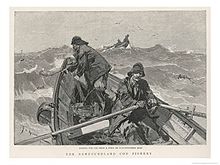- Cod fishing in Newfoundland
-
Main article: Cod fisheries
Cod fishing in Newfoundland was carried out at a subsistence level for centuries, but large scale fishing began shortly after the European discovery of the North American continent in 1492, with the waters being found to be preternaturally plentiful, and ended after intense overfishing with the collapse of the fisheries in the 1990s.
Contents
Native Canadian fishing
The Beothuk (called Skraelings by the Vikings) were the native people of Newfoundland, and survived on a diet of fish. With British and French coastal settlements, the Beothuk were forced inland, and coupled with the European propensity of murdering them on sight, the lack of their normal food source gradually decreased the Beothuk. By the 19th Century, the tribe no longer existed.[1]
15th and 16th Century
After his voyage in 1497, John Cabot's crew reported that
"the sea there is full of fish that can be taken not only with nets but with fishing-baskets".[2]
and around 1600 English fishing captains still reported cod shoals
"so thick by the shore that we hardly have been able to row a boat through them."[3]
In the early sixteenth century, fishermen from England, France, Spain and Portugal discovered the best places to fish for cod in the waters off Newfoundland, and how best to preserve the fish for the journey home.[4]
The French, Spanish and Portuguese fishermen tended to fish on the Grand Banks and other banks out to sea, where fish were always available. They salted their fish on board ship and it was not dried until brought to Europe. The English fishermen, however, concentrated on fishing inshore where the fish were only to be found at certain times of the year, during their migrations. These fishermen used small boats and returned to shore every day. They developed a system of light salting, washing and drying onshore which became very popular because the fish could remain edible for years.[2] Many of their coastal sites gradually developed into settlements, notably St. John's,[4] now the provincial capital.
In the late sixteenth century the Spanish and Portuguese fisheries were terminated, mainly as a result of the failure of the Spanish Armada,[2] and thereafter the English and French shared the fishery every summer until 1904 when the French agreed to relinquish it to the Newfoundland residents.[4]
Fishing methods and the fishery collapse
In 1951 factory fishing began with new super-trawlers such as the 'Fairtry'; 280 feet long and 2,600 gross tons.[3]
The cod catch peaked in 1968 at 810,000 tons, approximately three times more than the maximum yearly catch achieved before the super-trawlers. Approximately 8 million tons of cod were caught between 1647 and 1750, a period encompassing 25 to 40 cod generations. The factory trawlers took the same amount in 15 years.[5]
The industry collapsed entirely in the early 1990s owing to overfishing and debatably, greed, lack of foresight and poor local administration.[6] By 1993 six cod populations had collapsed, forcing a belated moratorium on fishing.[5] Spawning biomass had decreased by at least 75% in all stocks, by 90% in three of the six stocks, and by 99% in the case of 'northern' cod, previously the largest cod fishery in the world.[5]
After a 10 year moratorium on fishing the cod had still not returned.[7] It is likely that the local ecosystem has changed, one example being that greater numbers of capelin, which used to provide food for the cod, now eat the juvenile cod.[citation needed] The waters now appear to be dominated by crab and shrimp rather than fish.[7]
References
- ^ "Facts for kids:Beothuk Indians". Native Languages of the Americas. http://www.bigorrin.org/beothuk_kids.htm. Retrieved 2009-01-13.
- ^ a b c Pringler, Heather. "Cabot, cod and the colonists". Canadian Geographic. http://www.canadiangeographic.ca/specialfeatures/atlanticcod/cabot.asp. Retrieved 2008-10-06.
- ^ a b "A Run on the Banks How "Factory Fishing" Decimated Newfoundland Cod". E/The Environmental Magazine!. 2001-03. http://www.emagazine.com/view/?507. Retrieved 2009-01-13.
- ^ a b c Ryan, Shannon. "History of Newfoundland Cod Fishery". http://www.cdli.ca/cod/history5.htm. Retrieved 2008-06-20.[dead link]
- ^ a b c RA Myers, JA Hutchings, NJ Barrowman (1997). "WHY DO FISH STOCKS COLLAPSE? THE EXAMPLE OF COD IN ATLANTIC CANADA". Ecological Applications. http://as01.ucis.dal.ca/ramweb/papers-total/why_do_fish.pdf. Retrieved 2009-01-13.[dead link]
- ^ "CANADIAN ATLANTIC FISHERIES COLLAPSE". Greenpeace. http://archive.greenpeace.org/comms/cbio/cancod.html. Retrieved 2009-01-13.
- ^ a b Hirsch, Tim (2002-12-16). "Cod's warning from Newfoundland". BBC. http://news.bbc.co.uk/1/hi/sci/tech/2580733.stm. Retrieved 2009-01-13.
Further reading
- Outport Adaptations: Social Indicators Through Newfoundland's Cod Crisis, Hamilton & Butler, Univ of New Hampshire [1]
Categories:- Fisheries
- Fishing in Canada
- Economy of Newfoundland and Labrador
Wikimedia Foundation. 2010.

